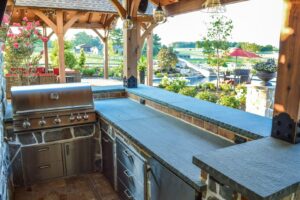
Keep reading for some helpful tips for winterizing your outdoor kitchen.
The outdoor cooking season may be coming to an end for you as the cool days and nights filter in, and this is when you should shut down your outdoor kitchen until next spring. To protect your outdoor kitchen, there are a few things you need to do to prepare it for months of winter inactivity. Follow these steps to winterize your outdoor kitchen once a year. This will extend the life of your kitchen and its components. Doing some extra work now also results in minimal set-up when you’re ready to start that first big outdoor cookout in the spring. Keep reading for some helpful tips for winterizing your outdoor kitchen.
Shut Off the Water Supply
Turning off the water connection to your outdoor kitchen is one of the most important steps of the winterizing process. Frozen water lines and burst pipes can cause expensive damage to your plumbing infrastructure, the outdoor sink, and the appliances to which it’s connected. Once your outdoor water connection has been shut off, drain the water supply lines by turning on the faucet. Make sure any water is also drained from any lines hooked up to your outdoor refrigerator and ice maker.
Clean Your Outdoor Kitchen
Outdoor appliances like fridges, freezers, and ice makers must be thoroughly cleaned before the season’s first freeze. Remove all food, especially perishable items, to ensure your appliances stay clean and fresh during winter. Next, give each appliance a thorough clean, both inside and outside, to ensure no stuck-on debris could attract rodents or other wildlife.
Prep Your Cabinets
Wooden and stainless steel cabinets must be winterized, too. Freezing temperatures can damage your cabinetry, especially finished wooden cabinets. Condition your wood cabinets with high-quality conditioner to prevent splitting or cracking. Stainless steel kitchen cabinets should be cleaned and polished before the first freeze to protect them throughout winter. After conditioning or polishing your cabinets, protect them with a durable canvas or cloth cover.
Winterize Your Grill
Give your grill some TLC, so it will be good to go in the spring. Remove the grill’s grates and warming rack and scrub off grease and food residue. Try to reach all those hard-to-reach places and remember to clean around the burners. After cleaning, use a stainless steel cleaner to polish your grill. Afterward, shut off the gas line if it’s a natural gas grill. Disconnect the gas line and cover up any openings on the end of the line and where it connects to the grill so no insects get inside.
If you have a propane grill and don’t plan to use it in the winter, disconnect the propane tank and store it upright outdoors in a well-ventilated area. To prevent the tank from rusting, keep it in a covered area. Never store a propane tank in an enclosed space like a garage or shed.
Questions? Lehnhoff’s Supply is Here to Help
If you still have more questions about winterizing outdoor kitchens, the trained professionals at Lehnhoff’s Supply are here to help you.
Find us at 2708 Belair Road, Fallston, MD 21047 and give us a call at 410-510-7646. For tips, tricks, and to see what we have been up to, be sure to follow us on Facebook, X – Twitter, and Pinterest!
We serve but aren’t limited to, the following parts of Maryland: Harford County – Fallston, Forest Hill, Joppa, Edgewood, Bel Air, Churchville, Havre de Grace, Jarrettsville, Street, Aberdeen, Abingdon, and Joppatowne. In Baltimore County: Kingsville, Perry Hall, Overlea, Fullerton, Nottingham, Parkville, Towson, Carney, Loch Raven, Lutherville, Timonium, Hunt Valley, Cockeysville, Sparks, Glyndon, Pikesville, Reisterstown, Ruxton, Parkton, Glen Arm, Baldwin, Monkton, Long Green, White Marsh, Rosedale, Phoenix, and Fork.
